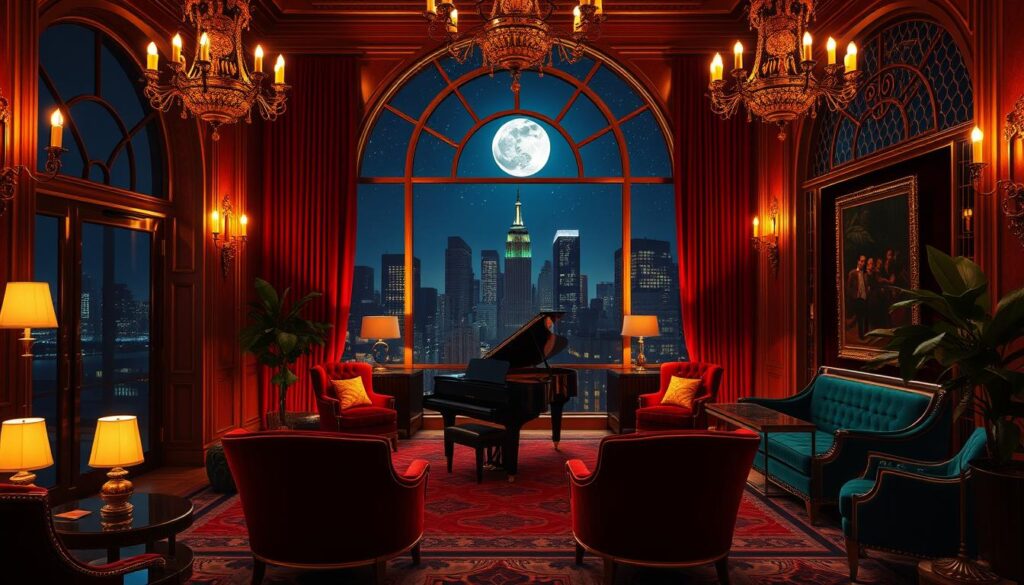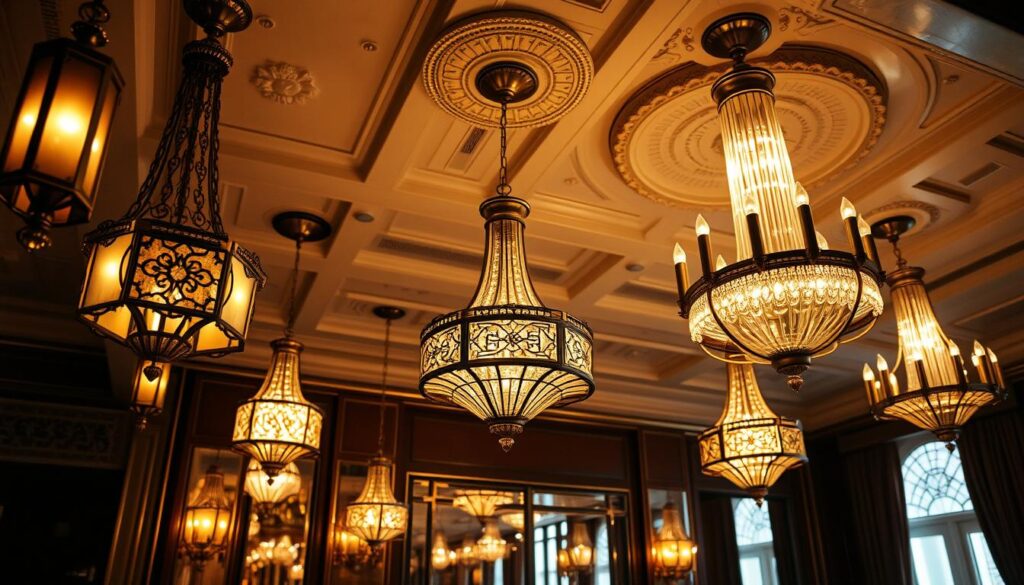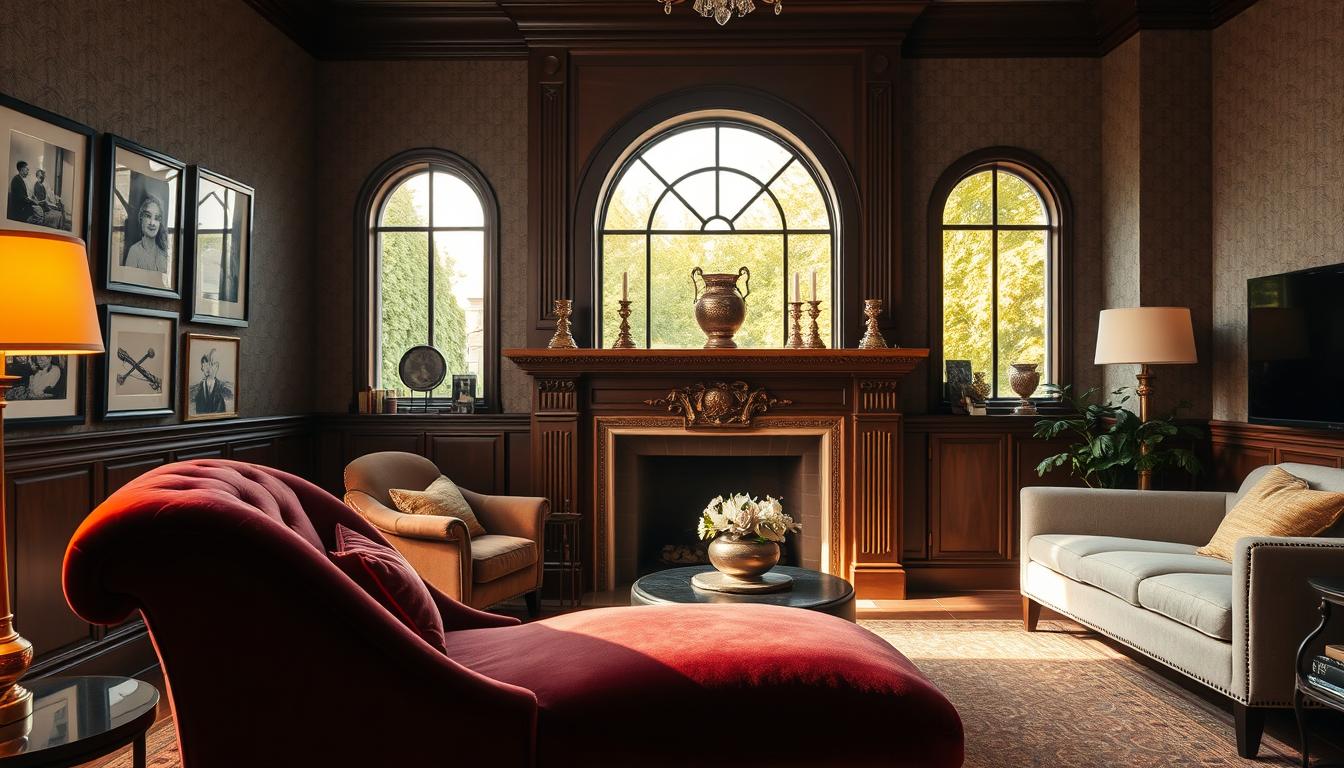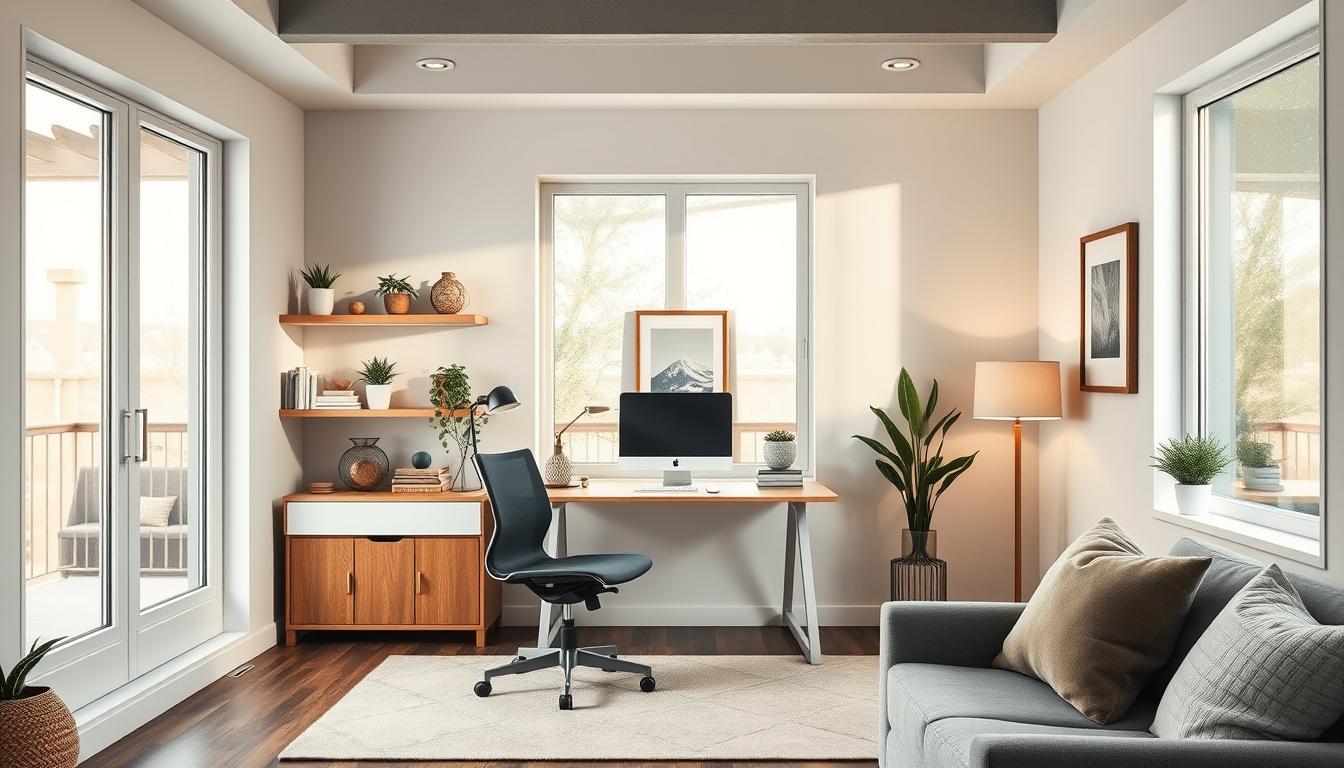The Roaring Twenties were a time of luxury and grandeur. This era still influences interior design today. It’s known for its rich patterns, shiny metals, and bold furniture pieces.
We can show you how to bring this glamorous era into your home decor. You’ll learn about using fancy fabrics and old-time accessories. Our tips will help you make a space that feels like the 1920s.
Key Takeaways
- Understand the key elements that define 1920s style
- Learn how to incorporate luxurious fabrics and textures
- Discover the importance of statement furniture and metallic accents
- Explore vintage accessories to add a touch of authenticity
- Create a cohesive look by balancing opulence with restraint
What Defined 1920s Home Interiors?
The 1920s were a time of grandeur and innovation in home decor. This era saw big changes in how people lived and decorated their homes. It was a time of luxury and new ideas.
Key Characteristics of the Era
1920s homes mixed old skills with new materials. Luxurious materials like marble and exotic woods were used to add opulence. New materials like chrome brought a modern feel to homes.
Popular Materials and Textiles
Textiles were key in 1920s home decor. Velvet, silk, and satin were favorites for furniture and curtains. These fabrics made rooms feel rich and welcoming. The bold patterns and colors added to the luxury.
Iconic Color Palettes
The 1920s were bold in color. Deep jewel tones like emerald green and sapphire blue were popular. Neutral colors like beige balanced these bold hues. This mix created a unique look for the era.
Essential Furniture Pieces for a 1920s Look
To create a 1920s-inspired home, choose classic home furnishings that capture the era’s style. The right furniture can take you back to the Roaring Twenties. It brings opulent decor and a sophisticated vibe to your space.
Choosing the Right Sofas and Chairs
The 1920s were all about luxurious living rooms. These rooms featured plush sofas and chairs in velvet and silk. Look for furniture with intricate carvings and antique interior accessories for that vintage charm.
Choose sofas and chairs with rolled arms and tufted upholstery. These were popular in the 1920s. They add comfort and make a statement in your living room.
Dining Room Essentials
The dining room was key in 1920s homes. It had a large, formal dining table and chairs. For an authentic look, pick a dining table with classic lines and sturdy construction. Chairs should have intricately carved details.
Also, add a sideboard or buffet to your dining room. These pieces were functional and let you display antique interior accessories like vintage china and crystal.
Accent Tables and Lighting
Accent tables and lighting were key in 1920s design. They added both function and style. Look for accent tables with unique shapes or geometric patterns, typical of Art Deco.
Lighting, like chandeliers and sconces, was often elaborate. Choose fixtures with a retro interior design look. They should have geometric shapes and metallic accents for that era’s glamour.
Incorporating Art Deco Style in Your Interiors
Exploring the 1920s through Art Deco style is a thrilling adventure. This movement, born in the 1920s, is known for its geometric shapes, metallics, and bold colors. These features define the era’s interior design.
Understanding Art Deco Design Elements
Art Deco is all about luxury and glamour. It uses geometric patterns, metallic accents, and bold colors to create a sophisticated look. Materials like chrome, glass, and inlaid wood add to the luxury of a room.
Key design elements for Art Deco include:
- Geometric shapes like triangles, circles, and zigzags
- Metallic materials such as chrome and silver
- Bold and bright colors, often used in contrast to neutral backgrounds
- Luxurious materials like velvet, silk, and inlaid wood
Art Deco Color Schemes
Art Deco colors are bold and vibrant. They mix neutral tones with bright, bold accents. Common Art Deco color schemes include:
| Color Scheme | Description |
|---|---|
| Neutral with Metallic Accents | Using neutral backgrounds with metallic accents like gold, silver, or chrome. |
| Bold and Bright | Incorporating bold, bright colors like red, blue, and green into the design. |
| Monochromatic with a Pop of Color | Using different shades of a single color with a bold accent color. |
Decorative Accessories to Consider
To complete the Art Deco look, the right decorative accessories are key. Popular items include:
- Vintage posters and prints
- Geometric-shaped vases and decorative objects
- Metallic accents like chrome or silver-plated items
- Luxurious textiles such as velvet and silk
By using these Art Deco elements, color schemes, and accessories, you can add 1920s glamour to your home.
The Impact of the Jazz Age on Interior Design
The Jazz Age brought a vibrant energy to interior design. It reflected the era’s love for jazz music and its cultural impact. This period, with its exuberant and liberated spirit, significantly influenced home styling. It incorporated elements that echoed the dynamic nature of jazz.

Music and Culture Reflected in Home Styling
The Jazz Age was more than music; it was a cultural phenomenon. It influenced interior design, making homes more expressive and eclectic. Furniture and decor started to embody the freedom and spontaneity of jazz music.
Key elements that reflected the Jazz Age in home styling include:
- Bold, geometric patterns inspired by Art Deco
- Vibrant color schemes that mirrored the energy of jazz performances
- Eclectic decor that combined vintage and modern pieces
Iconic Designs Inspired by Jazz
Jazz music’s influence on interior design led to iconic pieces. Designers experimented with new materials and shapes. They created furniture that was both functional and a statement piece.
The emphasis was on luxury, glamour, and the exotic. This reflected the global influences jazz music absorbed.
| Design Element | Inspiration | Characteristics |
|---|---|---|
| Geometric Patterns | Art Deco and jazz rhythms | Bold, metallic colors, and abstract shapes |
| Luxurious Fabrics | Opulence of jazz age performances | Velvet, silk, and intricate embroidery |
| Exotic Accents | Global influences in jazz | African, Asian, and Latin American motifs |
Creating a Musical Atmosphere
To capture the essence of the Jazz Age in your home, create a musical atmosphere. It’s more than just playing jazz music. It’s about crafting a space that feels alive and vibrant.
Tips for creating a musical atmosphere include:
- Using rich, bold colors on walls and furniture
- Incorporating luxurious fabrics like velvet and silk
- Adding statement lighting fixtures that evoke a sense of glamour
Textiles and Patterns in 1920s Decor
In the Roaring Twenties, luxurious fabrics and bold patterns were key in interior design. Textiles defined the era’s look, adding glamour and sophistication to homes.
Flamboyant Fabrics: Velvet and Silk
Velvet and silk were top choices for 1920s interiors. These materials brought opulence, with velvet for furniture and silk for drapes. They showed the era’s love for luxury and added texture to rooms.
Key Characteristics of Flamboyant Fabrics:
- Luxurious texture
- Rich, vibrant colors
- Opulent appearance
Art Deco Patterns: Geometric and Floral
Art Deco patterns, with geometric shapes and stylized flowers, were big in 1920s decor. These patterns were on wallpaper, fabrics, rugs, and more. Geometric shapes like chevrons and zigzags, and floral patterns with a modern twist, were used.
Incorporating Rugs and Curtains
Rugs and curtains were vital in 1920s interiors. They served both function and style. Rugs defined spaces and added warmth, while curtains controlled light and added drama. Choose rugs and curtains that match the room’s colors and patterns.
| Element | Purpose | Design Considerations |
|---|---|---|
| Rugs | Define spaces, add warmth | Choose patterns and colors that complement the room’s decor |
| Curtains | Control light, add drama | Select fabrics and patterns that enhance the room’s ambiance |
By using luxurious textiles, bold patterns, and well-chosen rugs and curtains, you can make a 1920s-inspired space. It will be full of glamour and sophistication.
Planning Your 1920s-inspired Color Scheme
To create a 1920s-inspired color scheme, you need to know the era’s bold and rich colors. The 1920s were all about luxury and glamour. This is seen in their vibrant colors and luxurious materials.
Understanding the 1920s color palettes is key. We’ll look at the main colors, how to mix neutrals with brights, and tips for balance.
Bold and Rich Color Choices
The 1920s were bold, with colors like emerald green, sapphire blue, and ruby red being popular. These colors added glamour to homes.
These colors were used in big ways, like on furniture and rugs. Start with a bold piece and balance it with neutral colors.
Mixing Neutrals with Vibrant Hues
Neutrals were also important in the 1920s. Shades like beige, cream, and ivory were used to balance bold colors.
Begin with a neutral wall color and furniture. Then, add color with accessories and rugs.
Achieving Balance in Color Usage
Getting your colors to work together is key. The 60-30-10 rule can help. Use 60% of a main color, 30% of a secondary, and 10% of an accent.
| Color Category | Percentage | Example Colors |
|---|---|---|
| Dominant Color | 60% | Neutral shades like beige or cream |
| Secondary Color | 30% | Rich colors like emerald green or sapphire blue |
| Accent Color | 10% | Bold colors like ruby red or gold |
By using the 60-30-10 rule and knowing the 1920s colors, you can make a stylish and balanced color scheme.
Bringing in Vintage Touches
The 1920s were known for their luxury, and vintage items can bring that back to your home. Adding vintage home decor makes your 1920s-inspired space feel real.
Authentic Vintage Finds
Finding real vintage pieces is key to a true 1920s home. Look for antique interior accessories at antique stores, flea markets, and estate sales. Choose items that show off the era’s skill and style, like detailed patterns, fancy fabrics, and ornate designs.
Restoring Vintage Treasures
Fixing up vintage items keeps their history alive and fits them into your historical home renovation. DIY projects can make old items shine again. First, check the item’s state, then find the right fix to keep its original look.
Blending Old with New
Mixing vintage and modern decor makes your space stand out. Try pairing old pieces with new ones for a cool contrast. For example, an antique chair with a modern sofa or old lights with new table lamps.
With careful vintage touches, your 1920s-inspired home will be truly special and unique.
Lighting: Setting the Mood for the 1920s
The art deco style of the 1920s used statement lighting to create luxury. These lights were not just for seeing; they were a key part of the room’s look.
Importance of Statement Lighting Fixtures
Statement lighting was key to the 1920s’ opulence. These lights had detailed designs and were made from materials like crystal and bronze. Chandeliers, in particular, were a hallmark of 1920s decor, serving as a focal point in living rooms and dining areas.

Styles to Consider: Chandeliers and Sconces
For 1920s-inspired lighting, chandeliers and sconces are essential. Chandeliers can be simple or elaborate, with crystal and metallic finishes. Sconces offer a softer light, perfect for hallways and bedrooms.
- Chandeliers: Look for designs with geometric patterns, metallic finishes, and frosted glass shades.
- Sconces: Opt for styles with ornate details, such as scrollwork or floral motifs, to add a touch of vintage charm.
Using Light to Enhance Ambiance
Lighting greatly affects a room’s feel. For a 1920s vibe, layer different lights for a warm atmosphere. Use overhead lights, table lamps, and floor lamps. Dimmable lighting is also great, letting you change light levels for any event.
Choosing and placing lights well can bring the 1920s to life in your home. You’ll create a sophisticated, glamorous space that honors the era’s classic furnishings.
Final Touches: Accessories to Complete Your Look
To make your 1920s home interiors pop, the right accessories are key. We can add vintage decor that captures the era’s glamour and elegance.
Decorative Accents of the Era
Decorative accents from the 1920s include metallics, ornate mirrors, and vintage figurines. These elements can make your vintage decor feel authentic.
Artwork that Resonates with the Era
Choose artwork that shows off the Art Deco style. Look for pieces with geometric patterns and bold colors. This will tie your 1920s-inspired space together.
Personal Items in Decor
Adding personal items like vintage collectibles or family heirlooms can make your decor special. It turns your space into something stylish and meaningful.
With these final touches, we can finish our 1920s look. Our space will then radiate the glamour of that era, thanks to the perfect accessories.


